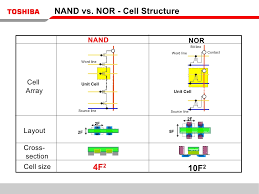NOR Flash and NAND Flash
2023-10-24
NOR Flash and NAND Flash are both memories, but they are also different. Now let Giantec introduce them to you in detail.

1. Concepts of NOR Flash and NAND Flash
Flash memory is a type of non-volatile memory that retains stored data without consuming power. According to the storage principle, Flash memory can be divided into two types: NOR Flash and NAND Flash. NOR Flash and NAND Flash are widely used in various electronic devices, such as smartphones, flash memory cards, solid-state drives, etc. However, although both are Flash memory chips, they have obvious differences in structure, performance and application.
NOR Flash is a memory based on logic gate circuits that can directly read and execute the program code stored in it. It is characterized by read and write operations at any location and high-speed random access. Therefore, it is often used to store key data such as startup programs and operating system kernels.
NAND Flash is a memory based on charge storage that stores data by controlling the voltage level of the memory cell. It is characterized by providing higher storage density within the same area, and therefore has lower production costs and higher storage capacity. NAND Flash is mainly used for large-capacity data storage, such as storage media for mobile phones, tablets and other mobile devices.
2. The difference between NOR Flash and NAND Flash
Storage principle: NOR Flash uses logic gate circuits for storage. Each storage unit has an independent address and can directly read and execute codes. Therefore, NOR Flash has the advantage of high-speed random access when storing program code. NAND Flash stores data through charge storage, and controls the voltage level of the storage unit to distinguish whether the stored data is 0 or 1. Since NAND Flash uses serial reading and writing, its reading and writing speeds are relatively slow.
Writing speed: Since the storage units of NOR Flash are connected in parallel, when writing, multiple storage units can be operated at the same time, so the writing speed is relatively fast. The storage units of NAND Flash are connected in series, and only one storage unit can be written at a time, so the writing speed is relatively slow.
Lifespan: Due to the slow writing speed of NAND Flash and the need to change the voltage level of the storage cell during writing operations, the service life of NAND Flash is relatively short. NOR Flash has a faster writing speed and does not need to change the voltage level of the memory cell for writing, so the service life of NOR Flash is relatively long.
3. Application scenarios of NOR Flash and NAND Flash
Since NOR Flash and NAND Flash each have different characteristics, advantages and disadvantages, their application scenarios are also different.
Application scenarios of NOR Flash: Because NOR Flash has the characteristics of high-speed random access, it is often used to store key data such as startup programs and operating system kernels. In addition, because NOR Flash can perform parallel read and write operations, it is also commonly used in application scenarios that require fast read and write operations, such as network equipment, automotive electronics and other fields.
Application scenarios of NAND Flash: Because NAND Flash has the advantages of high storage density and low production cost, it is mainly used for large-capacity data storage. For example, mobile devices such as mobile phones and tablets widely use NAND Flash as their internal storage media. In addition, because NAND Flash can perform serial read and write operations, it is also suitable for application scenarios that require long-term continuous read and write operations, such as solid-state drives (SSD).
4. Summary
To sum up, NOR Flash and NAND Flash are both very important types of Flash memory, each with different characteristics, advantages and disadvantages. In practical applications, we need to choose the appropriate Flash memory type according to different application scenarios and needs. In scenarios that require high-speed random access and code execution, we should choose NOR Flash; and in scenarios that require large-capacity and low-cost data storage, we should choose NAND Flash. Mastering the basic concepts, differences and application scenarios of NOR Flash and NAND Flash can allow us to better choose the appropriate storage solution and bring better performance and longer service life to electronic products.
Recommended News
-
How to Auto Run Flash in Chrome: A Guide to Managing Flash Content
2024-12月-24
-
How to Turn Off Auto Flash
2024-12月-23
-
What is the Difference Between NOR Flash and NAND Flash?
2024-12月-16
























